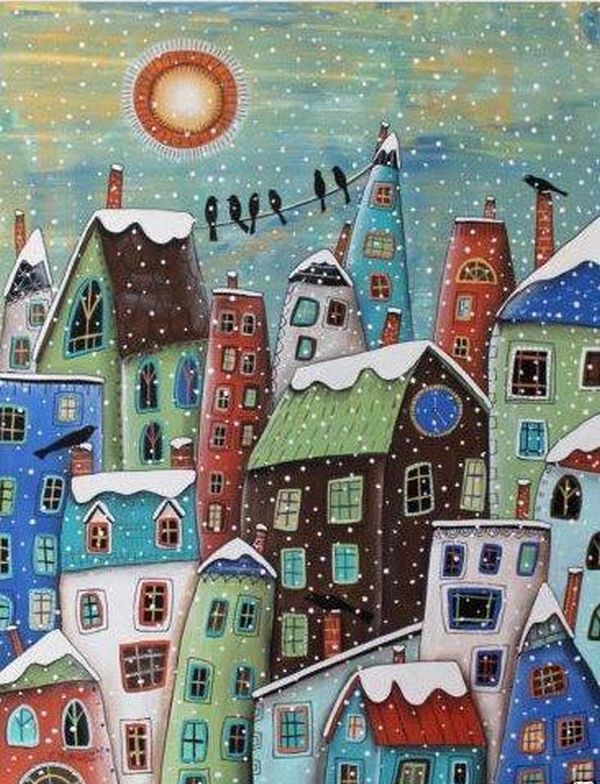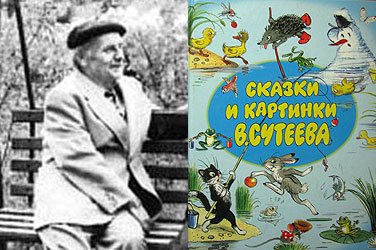Kazimir Malevich. Black Suprematistic Square. The description of a picture. Masterpieces of Russian painting. Картина квадраты
Под «Черным квадратом» Малевича обнаружили два цветных рисунка :: Впечатления :: РБК.Стиль
О результатах последних исследований «Черного квадрата» было объявлено 11 ноября на международной конференции, посвященной 100-летию картины, сообщает телеканал «Культура».
Научный сотрудник отдела научной экспертизы Третьяковской галереи Екатерина Воронина рассказала, что картину просветили рентгеновскими лучами, а кроме того, под микроскопом были рассмотрены кракелюры — трещины краски на поверхности «Черного квадрата». Сквозь них отчетливо просвечивался другой слой краски.

«Черный квадрат» в Третьяковской галерее
Ранее предполагалось, что под слоем черной краски скрывается другое изображение. «Мы выяснили, что таких изображений не одно, а два. И доказали, что первоначальное изображение — это кубофутуристическая композиция, а лежащая под «Черным квадратом» — это протосупрематическая композиция», — заявила Екатерина Воронина.

Изображения, скрытые под «Черным квадратом» стали видны в результате просвечивания рентгеновскими лучами
По ее словам, почти полностью удалось расшифровать и надпись, которую Казимир Малевич сделал на картине, впоследствии закрашенной «Черным квадратом». Фраза, по мнению ученых, звучит как «Битва негров в темной пещере». Таким образом работу Малевича можно считать аллюзией на картину 1882 года французского писателя и журналиста Альфонсо Алле. Более чем за четверть века до «Черного квадрата», в 1882–1884 годах, Алле изобрел свою «монохромную живопись» и написал картину «Битва негров в темной пещере глубокой ночью».
Все подробности проведенных исследований «Черного квадрата» будут опубликованы в специальном издании, которое появится в продаже в ближайшие 10 дней, сообщила «Русской службе новостей» генеральный директор Третьяковской галереи Зельфира Трегулова.
В 2015 году самая известная картина Каземира Малевича отмечает свое 100-летие. «Черный квадрат» входит в цикл супрематических работ художника, в которых он исследовал базовые возможности цвета и композиции. По замыслу Малевича, «Черный квадрат» являлся частью триптиха, в который также вошли «Черный круг» и «Черный крест».
Позднее Малевич выполнил несколько авторских повторений «Черного квадрата». Сейчас известны четыре варианта картины, различающиеся рисунком, фактурой и цветом. В Третьяковской галерее хранится именно подлинник 1915 года, с которого впоследствии делались повторения.
style.rbc.ru
Kazimir Malevich. Black Square. The description of the picture
The works, 39 of them, were shown at the second futurist exhibition (the "Zero-Ten Exhibition") in Petrograd. The room was dominated by the trademark «Black Square», officially titled «Four-Cornered Figure», which was hung high in one of the corners, almost like an icon, among paintings of other squares, rectangles, crosses, circles and other geometric shapes in a few basic colors, variously arranged on white backgrounds. These abstract and supremely basic paintings were expressions of a "higher consciousness" that progressive artists, both in Russia and abroad, had been talking about for the past years, where objects and concepts acquired a clear-cut simplicity. Malevich combined this idea with the traditional Russian piety that he had come to know in his childhood, giving his paintings an almost icon-like air.
 |
At the same time, the picture power bore in itself chaos and destruction, tightened the spectator in a chasm of world harm. Mentally weakened person could make after long contemplation of the «Black Square» a suicide. It has been noticed repeatedly.
«The Black Square» causes till now hot discussions. We will result absolutely opposite statements of critics: «The Square concentrates in itself infinite world space, bears expression« all »in an impenetrable black surface» (Sarabianov).
«In general, all grimaces and jumps round the «Black Square» remind a mass psychosis when people, not to seem the uneducated think out weight of beautiful words that nobody doubted that they have understood: this picture a true masterpiece. Remember G.H. Andersen and it tje «Dress of the King» (J. Ushakov).
Now we will result the opinion of the ordinary citizen placed on one of forums on the Internet: «the Black Square became a symbol of the end of an epoch of realism, romanticism, something ennobled and unearthly. It has absorbed all paints, has absorbed all schools in which young artists stayed for years. Has swallowed hundreds and thousand still-lifes, sketches and landscapes. Has swallowed even Monu Lizu. It symbolized itself the end of an epoch of a carolling of aspiration to beauty and idyll. It has shown something other - where all has come. Than all has ended».
In "Kitsur Shulhan Aruh" it is told: «On an establishment of wise men, it is necessary to leave on a wall opposite to an entrance door an unplastered square, the size an elbow on an elbow (48х48) that every time, having seen it, to remember the destroyed temple».
Malevich has executed the square according to the specified sizes. Similarity of a picture to a Judaic symbol in many respects can explain its improbable popularity. But not all could track the following analogy. The certificate of destruction of a temple has turned to the Darkness synonym. The darkness destroys and plunges into chaos temples and souls of people. «Eternal Darkness» named the «Black Square» in 1617 Robert Flud.
Malevich - the sectarian afflicted with creation of own belief. Its reports on art have religious names: «God won't throw off». It denies God of Shabby and New Precepts. A name to you the Cassimere. For Malevich there is no division into good and harm, God and the Devil. Its Universe - a stream faceless, безоценочных forms.
Temptation to create the world which does not have the bases in the Ox Divine, there was a celebration of the Devil of the Russian Modernism masking under abstract judgements, an aspiration to originality. Consequences of such choice bear till now terrible fruits.
«The artist who has prayed on a square, glanced in a black hole and not started back in horror, doesn't trust muses and angels; at it the, black angels, pragmatic and happy, knowing how much terrestrial glory and how to grasp it».
The transaction with the Devil has brought to Malevich a world fame. The black square is recognized by its best picture that an eye denying love to burn human souls, piercing them from the best catalogs, grasping in museums, at exhibitions. The black square seduces, entices, blinds, forcing to glorify it. Gradually it gets into an essence looking, forcing to renounce everything that is expensive, from close people, bases of outlook, belief to withdraw in emptiness, in destruction, in a zero.
On materials foru.ru It is translated by program PROMT http://www.promt.ru  |
Simple movement of a brush Malevich has once and for all spent непереходимую line, has designated a precipice between old art and new, between the person and its shade, between a rose and a coffin, between life and death, between God and the Devil. By its own words, it «has reduced all in zero». The zero has for some reason appeared square, and this simple opening — one of the most terrible events in art for all history of its existence…
Ingenious intuition of the artist, prophetical insight of the Founder it has groped the forbidden figure of the forbidden color — so simple that thousand passed by, crossing, neglecting, without noticing…
The few to it planned «a victory over the Sun», the few dared to throw down a challenge to the Prince of Darkness. Malevich has dared — and, as well as it is necessary in truthful stories about trade with the Devil, about возжаждавших Fausts, the Owner willingly and immediately was and has prompted to the artist the simple formula of a non-existence.
In the end of the same 1915 — already with might and main there was a First World War — the ominous cloth has been presented among other futurists at an exhibition. Malevich has simply hanged out all other works on walls in the usual image, it has intended to "Square" a special place. In the remained photo it is visible that «the Black square» is located in a corner, under a ceiling — there and how it is accepted to hang up an icon…
Malevich has meaningly hung out a black hole in a sacral place: the work he named «an icon of our time». Instead of "red" — black (a color zero), instead of the person — a failure (a zero of lines), instead of an icon, that is a window upwards, to the public, in eternal life — a gloom, a cellar, the hatch in an underworld, eternal darkness.
A.Benua, Malevich's contemporary, the magnificent artist and the critic of art, wrote about a picture: «the Black square in a white salary is not a simple joke, not a simple call, not the casual small episode which has happened in the house on the Mars field, and it is one of certificates of self-affirmation of that beginning which has the name nasty thing of desolation and which is proud of that it through arrogance, through arrogance, through violation of all love and gentle, will result all in destruction»…
During the period to "the suprematism" invention (Malevich's term) he professed "alogism", attempt to overstep the bounds of common sense, professed «struggle with логизмом, naturalness, petty-bourgeois sense and a prejudice». Its call has been heard, and the square has appeared before it and has incorporated it. The artist could be proud of that glory that the transaction with the Devil has brought to it; he also was proud…
Critics lovingly write about Malevich: "«the Black square» has incorporated all picturesque representations existing before, it bars the way naturalistic imitation, it is present as the absolute form and art in which free forms — not connected among themselves or interconnected — make sense of a picture" announces.
Truly, the Square "bars the way" — including to the artist. It is present «as the absolute form», — it is true also, but it means that in comparison with it all other forms aren't necessary, for they by definition aren't absolute. It «announces art...» — and here it has appeared a lie. It announces the art end, its impossibility, its uselessness, it is that furnace in which art burns down, a muzzle in which it fails…
| Alexander Blok. July 2, 1912. Worlds, years go by. The universe is bare. Its eyes of gloom are staring at us. And you, my soul, worn-out, unaware, Hold forth that happiness will come to pass... And what is happiness? The chilly evenings In darkening gardens, god-forsaken wood? Or vicious taste of wine, and wanton feelings, Perdition of the soul, and jovial mood? Is happiness a moment, brief and solid? Is it oblivion, a dream, and peace and quiet?.. As you wake up - it"s flight again, so horrid, Touching your heart, unknown crazy flight... You take a breath - and see you"re out of danger... That"s where you feel a sudden push again! The spinning-top set going by some stranger Flies buzzing in a hurry, like insane. As we get hold of sharp and sliding border And listen to the buzzing sound of chime,- Don"t we go mad amidst the motley order And change of made-up reasons, space and time?.. When will it stop? We won"t be able, really, To listen to this din without end... How terrible it is ! How wild ! Extremely! - Give me a hand, forget it all, my friend! |
www.tanais.info
К каком стиле написан "Черный квадрат ", другие работы в этом стиле?
В прошлом 2015 году исполнилось 100 лет со дня появления на свет знаменитой работы Казимира Малевича "Черный квадрат"- самой загадочной картины 20-го века.
Малевич работал в своей мастерской в Петербурге, обещал написать несколько картин для футуристической выставки "0,10". Сроки поджимали, а работа не клеилась.
Последние несколько лет он работал в стиле кубизма, который всем уже порядком надоел.
Вот и сейчас, ещё раз критически взглянув на свой кубический "шедевр", он понял - "не то"...
В отчаянии и сгоряча он взял кисть и замазал писанину черной краской, оставив белую рамку по краям,
решив завтра начать писать все сначала.
Через некоторое время в мастерскую зашел знакомый художник посоветоваться по вопросам подготовки
выставки, увидел на мольберте квадрат на белом фоне и воскликнул: "Гениально ! Это - шедевр !".
Искренен он был в своем восхищении или хотел польстить знаменитому художнику - сейчас трудно сказать, но "Черный квадрат" вместе с другими работами Малевича попал на выставку "0,10" и висел в самом почетном "красном углу", как икона.
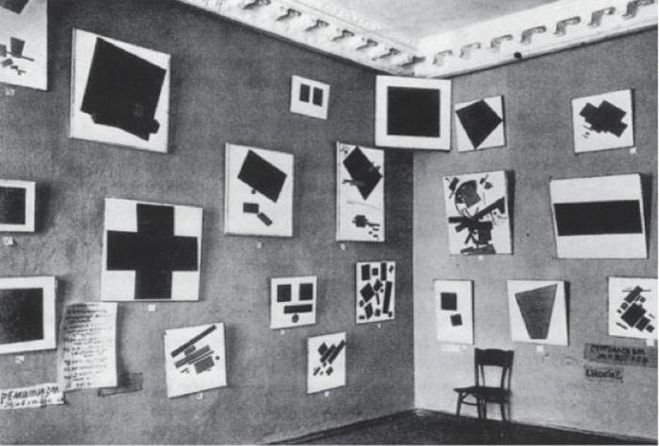
Несколько дней Малевич ничего не мог делать, размышляя, как объяснить всем, что он изобразил на холсте и как назвать своё произведение.
Решил назвать "Черный супрематический квадрат на белом фоне", а стиль в котором он написан - супрематизм.
Такова легенда и одна из версий появления этой композиции на свет.
Позже Малевич заявлял, что картина создана им под влиянием некоего "бессознательного космического сознания" и даже сумел философски обосновать это -

Супрематизм - это стиль беспредметной живописи, это акт " чистого творчества", оторванного от реальности окружающего мира, в нем цвет доминирует над всеми остальными свойствами композиции.
Одновременно для выставки были написаны ещё две работы - "Черный круг" и "Черный крест". Позже Малевич создал "Красный квадрат" и "Белый квадрат".
Работы Малевича были восприняты неоднозначно. Одни ценители искусства восхищались смелым футуристическим экспериментом, увидев в нем новые передовые веяния, другие в черном квадрате увидели "черную дыру, поглощающую светлую материю истинных художественных ценностей."
Как бы там ни было, но у Малевича появились ученики и последователи, которые стали работать в стиле супрематизма.
Многие из них входили в созданный им кружок "Супремус".
Лично меня особенно впечатлили работы участника этого кружка Ивана Клюна (Клюнова) 1873-1943).
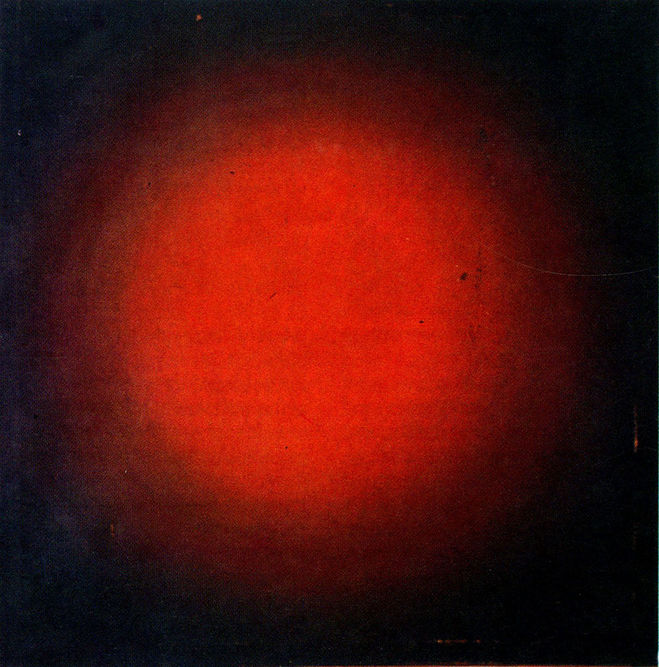
"Силуэт красного шара на фоне черноты". Поражает мистический пульсирующий красный цвет, пытающийся раздвинуть сжимающую его черноту.
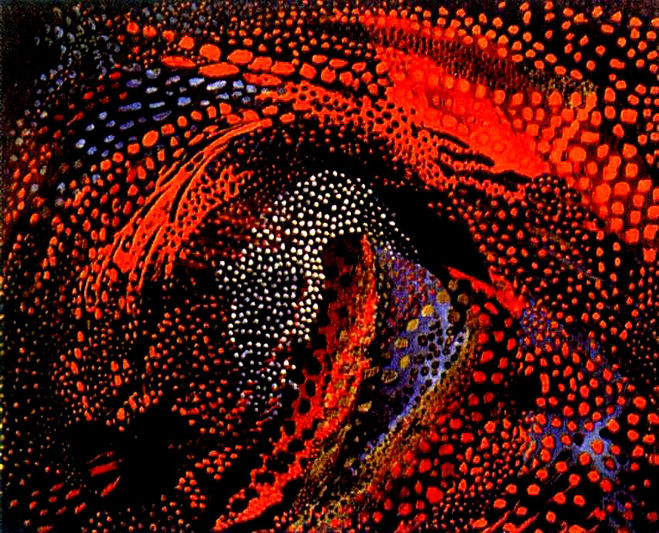
"Сферическая композиция красного цвета". У меня возникает ассоциация с космическим монстром-пришельцем из далёкой галактики.
Работа другого участника кружка "Супремус" Николая Суетина (1897-1954).
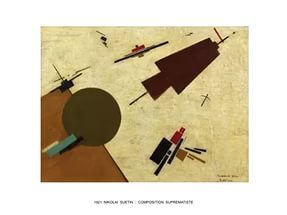
Н.Суетин был учеником и соратников К.Малевича, работал в области дизайна, графики, был живописцем. На рисунке прослеживается космическая тема. Что это - интуиция, предвидение ?
Александра Экстер (1882-1949) тоже хорошо известна в среде ценителей русского авангарда и одного из его направлений - супрематизма.
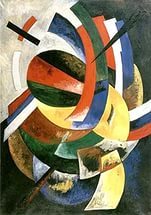
В стиле супрематизма работали также: Нина Генке (ученица А.Экстер), Розанова Ольга, Надежда Удальцова, Александр Родченко, Александр Древин и много других художников.
В работах супрематистов отсутствуют узнаваемые предметы реального мира, но зато в них есть особая цветовая, световая и эмоциональная выразительность, простор для неограниченной фантазии и размышлений, чтобы понять глубокое философское послание, зашифрованное художником.
Супрематизм стал заметной вехой в истории русского авангарда, в истории русской культуры и в развитии мирового искусства в целом.
www.bolshoyvopros.ru


